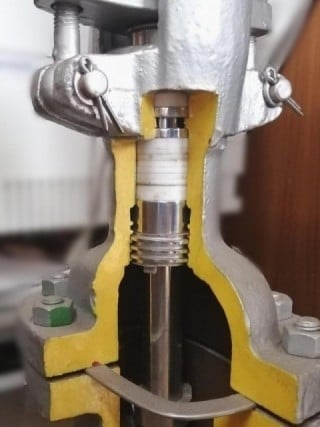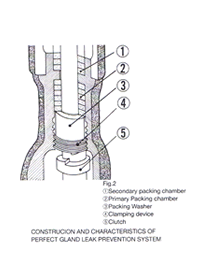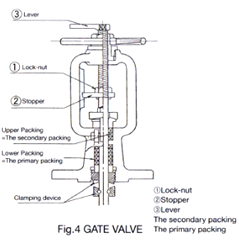1.About the new stuffing box type val
Problems with conventional stuffing box valves
In conventional stuffing boxes, when a tightening force is applied by the gland bolt, this tightening force is often absorbed in the upper layer as a component force in the direction perpendicular to the axis, and therefore, this tightening force is absorbed in the lower layer. The force will decrease rapidly.
On the other hand, the internal pressure gradually penetrates into the packing that is insufficiently tightened in the lower layer, and a seal is achieved only after about 2 turns of the packing in the upper layer that is sufficiently tightened.If sealant such as binder is blown away from this upper layer of packing, it will begin to leak to the outside.When this happens, internal fluid fills the packing chamber, so tightening the gland packing will temporarily seal it, but it will soon begin to leak.
On the other hand, the internal pressure gradually penetrates into the packing that is insufficiently tightened in the lower layer, and a seal is achieved only after about 2 turns of the packing in the upper layer that is sufficiently tightened.If sealant such as binder is blown away from this upper layer of packing, it will begin to leak to the outside.When this happens, internal fluid fills the packing chamber, so tightening the gland packing will temporarily seal it, but it will soon begin to leak.
“Twin Pack Valve” is a new stuffing box type valve proposed by Ishida Valve Industry.
The "Twin Pack Valve" has a unique structure that completely eliminates the drawbacks of conventional valves, and is a two-stage shaft sealing method in which the primary packing chamber ② and the secondary packing chamber ① are filled with gland packing.
2.Operation of Twin Pack Valves
(1)The primary packing of the Twin Pack valve should be tightened under these conditions:
- Before fluid runs in the lines after the construction pressure test, the primary packing should be tightened.
- At any sign of a small leak during plant operation, tightened the packing.
- At the annual plant maintenance shut down, the packing should be tightened.
(2)Procedure to apply pressure to the primary packing.
1.For a gate valve
- Open valve wide open by turning counter clockwise.
- Discontinue turning when the wheel stops.
- Release the lock nut to free the stopper.
- Turn the step top lever clockwise 30 to 45 degrees and the packing is clamped.
- Tighten the lock nut and place the stopper in the original positions. It is important to return to the initial state.
2.For a globe valve and a forged valve. (1 1/2" and smaller)
- Open valve wide open by turning counter clockwise.
- Discontinue turning when the wheel stops.
- Turn further in the same direction (counter clockwise) 30 to 45 degrees and the packing has been clamped.
(3)Maintenance instructions should call attention to the following:
- In case of these valves for control valves, isolation valves, or drain valves, the valves are not normally opened to the full open position which would have tightened the packing...So, during maintenance.
Shut-down, the valve should be opened to the full open position to tighten the primary packing. - It is good practice include the above maintenance information on the name plate of each valve.
- Any small leak is important and should not be ignored...Tighten the primary packing and also tighten the secondary packing to insure a sure seal.
- For the gate valve, do not turn the lever to the left after the primary packing has been clamped. The screw of the clutch returns to the original position and, if the lever is turned to the left, the clamped packing can become loose.
- For the glove valve and forged valve (1 1/2" and smaller), do not use a hacker (a wheel key), if the valve is opened with the wheel key, the primary packing may be closed too much.
- To replace the primary packing with new packing, disassemble the cluch from the bonnet with the tools.
3.Twin Pack valves can be used on special fluids and special
- For heating media
Downtherm A, Therm S, S-K Oil, Marlotherm, Essotherm, HTS, Hygrotherm, Fused Lead, Fused Sodium, Fused Potassium, etc - For high pressure, high temperature steam
Downtherm A, Therm S, S-K Oil, Marlotherm, Essotherm, HTS, Hygrotherm, Fused Lead, Fused Sodium, Fused Potassium, etc - For hazardous gas and liquids such as hydrogen
chloride (refer to the Yellow Twin Pack), hydrogen sulfide, phosgene, carbon monoxide, etc. - For prevention of pollution by preventing leaks of sulfurous acid gas, acetic acid, carbon dioxide.
- For use for vacuum to a maximum 10-2mm Hg.
- For low molecular weight gases Hydrogen, Oxygen, Freon, Gas, LPG etc.
- For nuclear power plant.
4.Specifications
Twin Pack Valves are designed, the same as common valves, to conform to API 600, and ANSI B16.5 and the same pressure/temperature ratings apply. Please refer to attached tables for 150#, 300#, 10K, and 20K, standard valves.
- Nominal pressure class
150#, 300#, 600#, 900#, 1500#, 10K, 20K, 40K, 63K - Nominal bore size
1/2"~36" - Available as gate valves or globe valves
5.Materials
- Body material for Twin Pack valves is in accordance
with API 600. Common materials are carbon steel, alloy steel, and stainless steel. Other materials like monel can be supplied as required by the customer.
Standard trim materials are 13 Cr and 18-8 stainless steel. Monel and other materials are available. - Material for trim
13Cr and 18-8 stainless steels, etc are used in conformity with API STD 600.
Special material, such as Monel metal, may be used when so requested by customer, as well.





